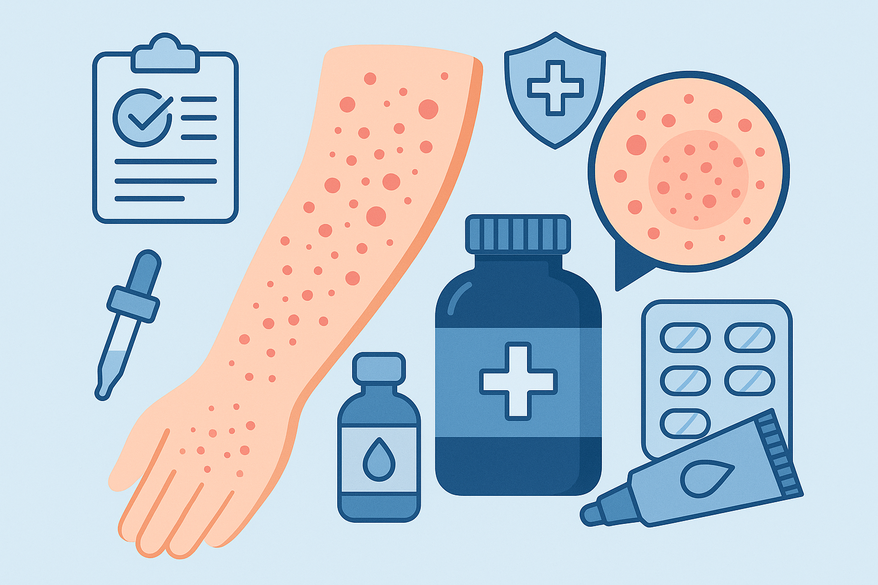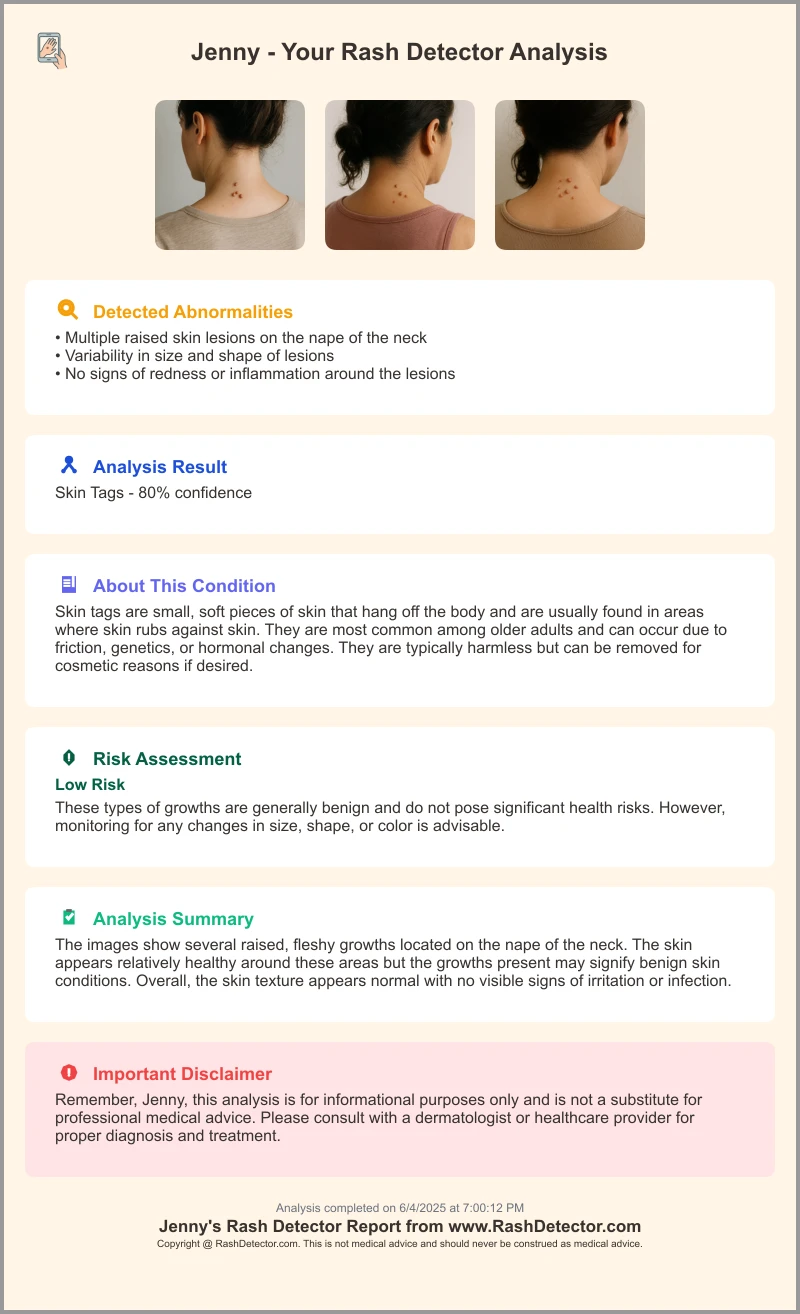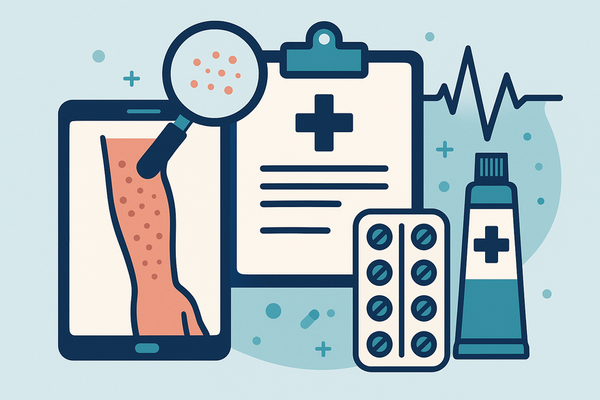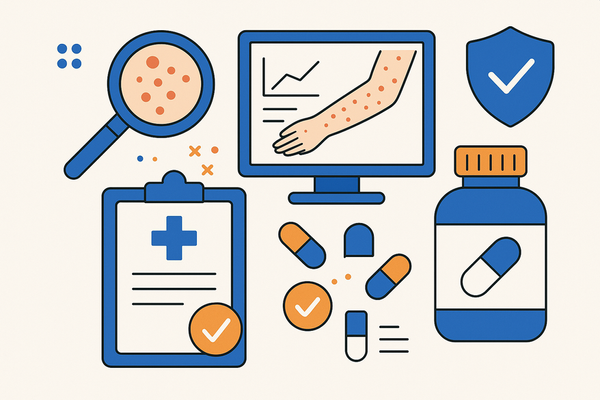Comprehensive Guide to Medication Rash Treatment
Learn about effective medication rash treatment, identification, and prevention of drug-induced skin reactions with our comprehensive guide.

Estimated reading time: 8 minutes
Key Takeaways
- Early recognition of drug-induced rashes prevents serious complications.
- Differential diagnosis is crucial to distinguish medication rashes from other dermatoses.
- Management ranges from over-the-counter remedies to hospital-based care for severe reactions.
- Maintaining an accurate drug allergy history helps avoid future episodes.
- Red-flag symptoms like widespread blistering or airway compromise require immediate medical attention.
Table of Contents
- Introduction
- Understanding Medication-Induced Rash
- Identification and Diagnosis
- Medication Rash Treatment Options
- Managing and Preventing Future Reactions
- When to Seek Medical Help
- Conclusion
- FAQ
Introduction
A medication rash is any unintended skin reaction triggered by a pharmaceutical agent, ranging from mild redness to severe blistering. These cutaneous eruptions can manifest as erythema, bumps, hives, or peeling, and may lead to significant discomfort—or even life-threatening complications. Prompt recognition and care are key.
Research shows that over 90% of oral or injectable medicines can provoke skin eruptions of varying frequency.
For those seeking an instant preliminary analysis of a suspicious rash, tools like the Skin Analysis App leverage AI to generate sample reports from your photos.

Understanding Medication-Induced Rash
A medication-induced rash is an adverse hypersensitivity response to drug intake. Common presentations include:
- Maculopapular eruptions (flat or raised red bumps)
- Urticarial lesions (hives or welts)
- Intense itching, blistering, or peeling skin
Common culprits:
- Antibiotics: penicillins, sulfonamides, cephalosporins
- Antiepileptics: carbamazepine, phenytoin
- NSAIDs: ibuprofen, naproxen
- Targeted cancer therapies: protein kinase inhibitors, monoclonal antibodies
Distinguishing a medication rash from viral exanthems, eczema, or psoriasis is crucial. For more detailed criteria on identifying drug-induced rash features, consult this resource.
Identification and Diagnosis
Recognizing both dermatologic and systemic warning signs guides effective treatment:
Key Dermatologic Signs- Itchy red spots or plaques (erythematous macules and papules)
- Hives or welts (urticaria)
- Blisters, bullae formation, or peeling skin
- Fever
- Lymphadenopathy (swollen lymph nodes)
- Facial swelling and difficulty breathing
Severe syndromes include DRESS (Drug Reaction with Eosinophilia and Systemic Symptoms), Stevens-Johnson syndrome (SJS), and toxic epidermal necrolysis (TEN). Most rashes appear within hours to two weeks of starting a new drug; severe syndromes may be delayed.
Professional evaluation requires:
- Detailed drug history review
- Physical skin examination
- Laboratory tests (CBC, eosinophil count)
- Skin biopsy if needed
Medication Rash Treatment Options
Treatment depends on severity:
- OTC Remedies: Oral antihistamines (diphenhydramine, cetirizine); topical 1% hydrocortisone.
- Prescription Therapies: Systemic corticosteroids (prednisone taper); prescription antihistamines (fexofenadine, loratadine); IV immunoglobulin or cyclosporine for SJS/TEN or DRESS.
- Supportive Measures: Cool compresses, fragrance-free moisturizers; avoid heat, tight clothing, and harsh soaps.
- Cautions: Do not abruptly stop or switch medications without a physician; monitor for infection in open blisters.
Managing and Preventing Future Reactions
Key strategies:
- Allergy Documentation: Maintain an up-to-date list of drug allergies and rash events.
- Alternative Regimens: Under clinician guidance, switch to non–cross-reactive drug classes or adjust dose/route.
- Proactive Monitoring: Schedule follow-ups when initiating high-risk drugs; daily self-checks for new symptoms.
- Specialized Testing: Skin prick or patch tests; desensitization protocols for essential medications.
For insights on long-term management of drug allergy rashes, see this guide.
When to Seek Medical Help for Medication Rash Treatment
Emergency warning signs:
- Severe facial, tongue, or throat swelling (airway compromise)
- Widespread blistering or peeling skin, mucous membrane involvement
- High fever (>38.5°C), rapid rash progression, systemic malaise
Prepare for your visit by noting:
- Onset timing relative to medication start
- Rash appearance, spread, and associated symptoms
- Complete medication list with dosages and durations
- Prior rash episodes with similar drugs
Conclusion
Prompt recognition and evidence-based management of medication rashes are vital to prevent complications. Always involve a healthcare professional before modifying any drug regimen. Maintain thorough documentation, engage in proactive monitoring, and communicate openly with your medical team to ensure safer therapies.
FAQ
- How soon can a medication rash appear?
The majority occur within hours to two weeks after starting a new drug, though severe reactions may be delayed up to several weeks. - Can I treat mild rashes at home?
Yes—oral antihistamines and low-potency topical corticosteroids often suffice for mild cases. - When should I stop the offending drug?
Never discontinue without medical advice; abrupt cessation can cause rebound or withdrawal issues. - Are patch tests reliable?
Patch and skin-prick tests help confirm specific hypersensitivities but should be interpreted by an allergist or dermatologist. - What if I need the drug despite a rash?
Desensitization protocols exist for essential medications—always conducted under close clinical supervision.





